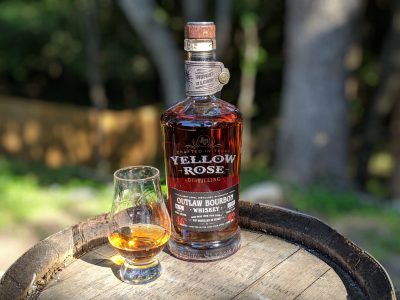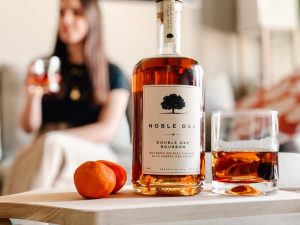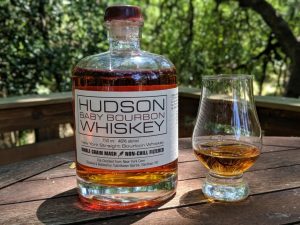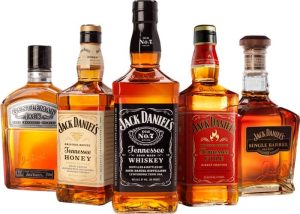Are you a fan of rich, smooth, and complex flavors? If so, then bourbon might be the perfect spirit for you. But what exactly is bourbon, and what makes it so special? Also, what is bourbon made from? Let us find out on this page.
Bourbon is a type of American whiskey that is made from a mixture of grains, with at least 51% of the mixture being corn. The remaining grain mixture is usually made up of barley, rye, and wheat. The grains are ground into a meal and mixed with water to create a mash.
The mash is then placed into a fermenting tank where it is allowed to sit for several days to allow the natural yeasts present in the grains to ferment the sugars in the mash into alcohol. Once the fermentation process is complete, the liquid is then distilled to increase the alcohol content and aged in oak barrels for several years to develop its flavor and character.
What is bourbon made from?
Bourbon is a type of American whiskey that is made from a mixture of grains, with at least 51% of the mixture being corn. The other grains that are commonly used in the production of bourbon include barley, rye, and wheat.
To make bourbon, the first step is to create a mash by mixing the grains with water and heating them to convert the starches into sugars. The resulting liquid, called the “mash bill,” is then fermented by adding yeast, which consumes the sugars and produces alcohol.
Next, the fermented liquid is distilled or heated to separate the alcohol from the other components of the mash. The resulting distillate is then aged in charred oak barrels, which gives bourbon its characteristic amber color and flavors of vanilla and caramel.
After aging, the bourbon is usually diluted with water to reduce its alcohol content and bottled for distribution. The length of the aging process varies, but most bourbons are aged for at least two years. Some types of bourbon, such as single barrels and small batches, are made from a selection of barrels that are chosen for their unique flavors and characteristics.
What makes bourbon different from whiskey?
Bourbon is a type of whiskey, but there are a few key characteristics that set it apart from other types of whiskey.
First and foremost, bourbon must be made from a mixture of grains that includes at least 51% corn. This gives bourbon its distinct sweet flavor.
Bourbon must also be aged in new, charred oak barrels. This imparts flavors of vanilla and caramel to the whiskey and gives it its amber color.
In addition, bourbon must be distilled to no more than 160 proof (80% alcohol by volume) and aged at no more than 125 proof (62.5% alcohol by volume).
Finally, bourbon must be made in the United States. While it can be made in any state, most bourbon is produced in Kentucky.
There are other types of whiskey, such as scotch, Irish whiskey, and Canadian whiskey, that have their own production requirements and characteristics. These types of whiskey are typically made from different mixtures of grains and aged in barrels that have been used for other purposes, such as sherry or port.
Is jack daniel’s bourbon?
Yes, Jack Daniel’s is a brand of bourbon whiskey. It is produced by the Jack Daniel Distillery, which is located in Lynchburg, Tennessee.
To be classified as bourbon, a whiskey must meet certain production requirements. These include being made from a mixture of grains that includes at least 51% corn, being aged in new, charred oak barrels, being distilled to no more than 160 proof (80% alcohol by volume), and being aged at no more than 125 proof (62.5% alcohol by volume).
Jack Daniel’s meets all of these requirements and is, therefore, a bourbon whiskey. It is known for its distinctive flavor, which is achieved through a combination of the specific grain mixture used in its production and the process of filtering the whiskey through sugar maple charcoal before it is aged.
Bourbon whiskey brands
There are many brands of bourbon whiskey available, including:
- Jim Beam
- Maker’s Mark
- Wild Turkey
- Old Forester
- Bulleit Bourbon
- Four Roses
- Knob Creek
- Woodford Reserve
- Evan Williams
- Elijah Craig
These are some of the most well-known and widely available brands of bourbon, but there are many smaller craft distilleries that also produce high-quality bourbon.
Some of these craft brands include:
- Buffalo Trace
- Heaven Hill
- Michter’s
- Old Pogue
- Rowan’s Creek
- Willett
- Lexington Bourbon
- Belle Meade Bourbon
- Calumet Farm
- Wilderness Trail
What is the process for making bourbon whisky?
Bourbon is a type of American whiskey that is made from a mixture of grains, with at least 51% being corn.
The process of making bourbon involves several steps, including:
1. Milling: The first step in making bourbon is to mill the grains, which involves grinding them into a fine powder. This can be done using a hammer mill or a roller mill.
2. Mash preparation: The milled grains are mixed with water to create a mixture called the mash. The mash is typically made up of about 70% grain and 30% water.
3. Fermentation: The mash is transferred to a fermentation tank, where it is mixed with yeast. The yeast consumes the sugars in the mash and converts them into alcohol. This process takes several days to complete.
4. Distillation: Once the fermentation process is complete, the liquid, known as the wash, is ready for distillation. During distillation, the wash is heated until the alcohol boils and evaporates. The resulting vapor is then cooled and condensed back into a liquid, resulting in a clear, high-proof spirit.
5. Aging: The clear spirit is then transferred to oak barrels, where it will age for several years. The oak barrels impart flavor and color to the bourbon during the aging process.
6. Bottling: Once the bourbon has aged for the required amount of time, it is ready to be bottled. It is typically diluted with water to bring the proof down to a drinkable level before it is bottled and labeled for sale.
There are many variations in the process of making bourbon, as different distilleries have their own recipes and techniques. However, these are the basic steps involved in the production of bourbon whiskey.
What grains are used to make bourbon?
Bourbon is made from a mixture of grains, with at least 51% being corn. The other grains that may be used in the production of bourbon include barley, rye, and wheat.
The specific combination of grains used to make bourbon is known as the “mash bill.” The mash bill will vary depending on the distillery and the specific brand of bourbon being produced. Some distilleries may use a mash bill that is primarily corn, while others may use a more balanced mixture of grains.
In addition to the required 51% corn, the mash bill for bourbon may also include a small amount of malted barley, which helps to convert the starches in the grains into sugars during the mashing process. The use of rye and wheat in the mash bill can add flavor and complexity to the finished bourbon.
What role does water play in the production of bourbon?
Water plays several important roles in the production of bourbon. Firstly, water is used to mill the grains, which involves grinding them into a fine powder. This is typically done using a hammer mill or a roller mill.
Secondly, water is used to create the mash, which is a mixture of milled grains and water. The mash is typically made up of about 70% grain and 30% water. The water helps to extract the sugars and flavors from the grains during the mashing process.
Thirdly, water is used to dilute the high-proof spirit that is produced during the distillation process. The spirit is typically diluted with water to bring the proof down to a drinkable level before it is bottled and sold.
Finally, water is also used to clean and sanitize the equipment and facilities used in the production of bourbon. Overall, water plays a vital role in the production of bourbon and is an essential component of the process.
What is the role of oak barrels in the flavor of bourbon whisky?
Oak barrels play a crucial role in the flavor of bourbon whiskey. During the aging process, the bourbon absorbs flavors and colors from the oak barrels in which it is aged.
The oak barrels used to age bourbon are typically made from American white oak, which impart flavors of vanilla, coconut, and dill to the bourbon. The barrels are also toasted and charred on the inside, which adds flavors of caramel, toffee, and spice to the bourbon.
In addition to adding flavor, the oak barrels also help to filter and smooth out the bourbon, giving it a smoother, more refined taste.
Overall, oak barrels are an essential component of the flavor of bourbon, and the aging process is an important factor in determining the final flavor profile of the whiskey.
How is bourbon aged, and for how long?
Bourbon is aged in oak barrels, which are typically made from American white oak. The barrels are toasted and charred on the inside, which adds flavors and colors to the bourbon as it ages.
Bourbon must be aged for a minimum of two years in order to be called “bourbon,” although most bourbons are aged for much longer. The aging process can take anywhere from four to twenty years, depending on the brand and the specific flavor profile the distillery is trying to achieve.
During the aging process, the bourbon is stored in warehouses, where it is subject to variations in temperature and humidity. These variations cause the bourbon to expand and contract as it ages, which helps to extract flavors and colors from the oak barrels.
As the bourbon ages, it will lose some of its alcohol content through evaporation. This process, known as the “angel’s share,” typically results in the loss of about 2-4% of the bourbon’s volume each year.
Once the bourbon has aged for the required amount of time, it is ready to be bottled. It is typically diluted with water to bring the proof down to a drinkable level before it is bottled and labeled for sale.
Overall, the aging process is an important factor in determining the final flavor profile of bourbon whiskey, and the length of aging can have a significant impact on the taste of the finished product.
What is the difference between the single barrel and blended bourbon?
Single barrel bourbon is a bourbon that is aged in a single oak barrel, while blended bourbon is a blend of bourbon from multiple barrels.
Single barrel bourbons
Single barrel bourbons are typically made from a single batch of mash and are bottled from a single barrel.
As a result, they tend to have a more distinct flavor profile, as the flavors and characteristics of the bourbon are influenced by the specific barrel in which it was aged. Single barrel bourbons may also vary in flavor from one barrel to the next due to differences in the barrels, aging conditions, and other factors.
Blended bourbons
Blended bourbons, on the other hand, are made by blending together bourbon from multiple barrels. The goal of blending is to create a consistent flavor profile from one batch to the next. Blended bourbons may be made from a variety of different barrels and ages, and the specific blend of bourbons used will depend on the desired flavor profile of the finished product.
In addition, the main difference between the single barrel and blended bourbon is the way in which they are produced and the degree of consistency in the finished product.
Single barrel bourbons are made from a single barrel and tend to have a more distinct flavor profile, while blended bourbons are made by blending together bourbon from multiple barrels and are intended to have a more consistent flavor.
How is bourbon whisky classified by the region in the United States?
Bourbon is a type of American whiskey that is primarily produced in the United States, and it has a strong association with the state of Kentucky. However, bourbon can legally be produced in any state in the United States as long as it adheres to the regulations set forth by the federal government.
Despite this, bourbon is often associated with the state of Kentucky, and many bourbon distilleries are located in this region. Some people may refer to bourbon produced in Kentucky as “Kentucky bourbon,” but this is not an official classification.
The federal government does not classify bourbon by region. Instead, bourbon is classified based on the production process and the ingredients used.
In order to be called bourbon, the whiskey must be made from a mixture of grains, with at least 51% being corn, and it must be aged in new, charred oak barrels. It must also be produced in the United States and must be bottled at a minimum of 80 proof.
What are the most famous bourbon-producing regions in the United States?
Bourbon can be legally produced in any state in the United States as long as it meets the regulatory requirements for the production of bourbon, which include being made from a mixture of grains with at least 51% corn and being aged in new, charred oak barrels.
However, bourbon has a strong association with the state of Kentucky, and many bourbon distilleries are located in this region.
Some of the most famous bourbon-producing regions in the United States include:
1. Kentucky: Kentucky is known as the “bourbon capital of the world,” and many of the most famous bourbon brands are produced in this state. Some of the most well-known bourbon distilleries in Kentucky include Jim Beam, Maker’s Mark, and Four Roses.
2. Tennessee: Tennessee is another major bourbon-producing region in the United States. Tennessee whiskey is similar to bourbon, but it must be produced in Tennessee and must be filtered through maple charcoal before it is aged. Some of the most well-known Tennessee whiskey brands include Jack Daniel’s and George Dickel.
3. Indiana: Indiana is home to several bourbon distilleries, including MGP Ingredients, which produces a wide range of bourbon brands.
4. Virginia: Virginia is home to several bourbon distilleries, including A. Smith Bowman Distillery and Copper Fox Distillery.
5. Colorado: Colorado is home to several bourbon distilleries, including Stranahan’s Colorado Whiskey and Breckenridge Bourbon.
How is the strength of bourbon whisky measured?
The strength of bourbon whiskey is typically measured in terms of its alcohol content or “proof.” The proof is a measure of the alcohol content of a beverage and is expressed as twice the percentage of alcohol by volume. For example, a bourbon that is 50% alcohol by volume would be 100 proof.
Bourbon must be bottled at a minimum of 80 proofs in order to be called bourbon. However, many bourbons are bottled at higher proof levels, and the specific proof of a bourbon will depend on the brand and the desired flavor profile.
The proof of bourbon can be determined by using a hydrometer, which is a tool that measures the density of a liquid. By measuring the density of the bourbon and comparing it to the density of water, the alcohol content of the bourbon can be calculated.
In addition, the strength of bourbon is typically measured in terms of proof, which is a measure of the alcohol content of the beverage. Bourbon must be bottled at a minimum of 80 proofs in order to be called bourbon.
What are the different types of bourbon whisky?
There are several different types of bourbon, which can vary in terms of flavor profile, production methods, and other factors. Some of the different types of bourbon include:
1. Straight bourbon: Straight bourbon is a bourbon that has been aged for a minimum of two years in new, charred oak barrels. It must also be made from a mixture of grains with at least 51% corn and must be bottled at a minimum of 80 proof.
2. Single barrel bourbon: Single barrel bourbon is a bourbon that is aged in a single oak barrel rather than being blended from multiple barrels. Single barrel bourbons tend to have a more distinct flavor profile, as the flavors and characteristics of the bourbon are influenced by the specific barrel in which it was aged.
3. Small batch bourbon: Small batch bourbon is a blend of bourbon from a small number of barrels, typically no more than a few hundred. The goal of small-batch bourbon is to create a more consistent flavor profile from batch to batch.
4. Bottled in bond bourbon: Bottled in bond bourbon is a bourbon that has been aged for a minimum of four years and has been bottled at a minimum of 100 proof. It must also be produced at a single distillery, using the same recipe, in a single distilling season.
5. High rye bourbon: High rye bourbon is a bourbon that is made with a higher proportion of rye in the mash bill. The use of rye in the mash bill can add flavors of spice and pepper to the finished bourbon.
What are some common flavor profiles found in bourbon whisky?
The specific flavor profile of bourbon will depend on the grains used in the mash bill, the aging process, and other factors. Some common flavor profiles found in bourbon include:
1. Caramel and toffee: These flavors are often imparted to bourbon by the oak barrels in which it is aged. The barrels are typically toasted and charred on the inside, which adds flavors of caramel and toffee to the bourbon.
2. Vanilla and coconut: These flavors are also often imparted to bourbon by the oak barrels. The barrels are typically made from American white oak, which imparts flavors of vanilla and coconut to the bourbon.
3. Fruit: Bourbon can sometimes have flavors of fruit, such as cherry or apple. These flavors may be derived from the grains used in the mash bill or may be imparted by the oak barrels during the aging process.
4. Spice: The use of rye in the mash bill can add flavors of spice, such as pepper and clove, to the finished bourbon.
5. Honey and butterscotch: These flavors are often found in bourbon and are derived from the interaction of the grains and the oak barrels during the aging process.
Conclusion
Do you want to know what is bourbon made from? Then you are just in the right place. Bourbon is a type of American whiskey that is made from a mixture of grains, with at least 51% being corn. The other grains that may be used in the production of bourbon include barley, rye, and wheat.
The specific combination of grains used to make bourbon is known as the “mash bill,” and the proportions of each grain used will vary depending on the brand and the desired flavor profile.
In addition to the required 51% corn, the mash bill for bourbon may also include a small amount of malted barley, which helps to convert the starches in the grains into sugars during the mashing process.
The use of rye and wheat in the mash bill can add flavor and complexity to the finished bourbon. Overall, bourbon is a complex and flavorful whiskey that is made from a mixture of grains, with at least 51% being corn.




